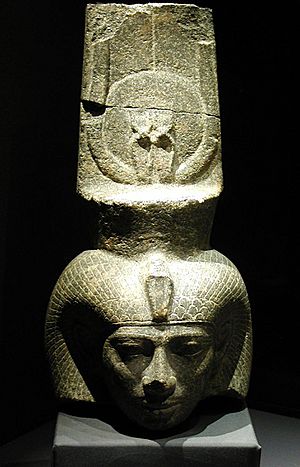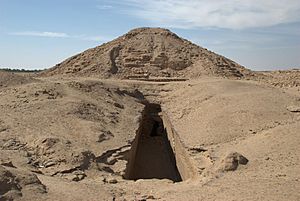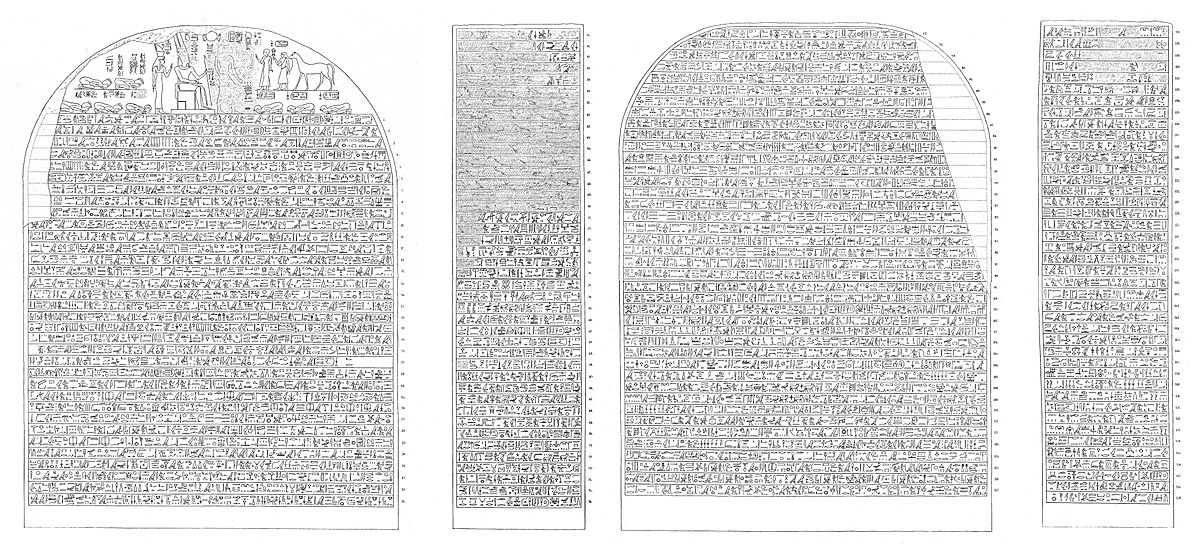Piye facts for kids
Quick facts for kids Piye |
|
|---|---|
| Piankhi, Piankhy, Paankhi, Paanchi | |
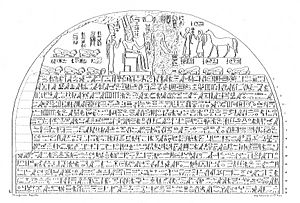
Drawing of the upper part of the victory stele of pharaoh Piye. The lunette on the top depicts Piye being tributed by various Lower Egypt rulers, and the text describes his successful invasion of Egypt. While the stela itself dates back to Piye's reign in the Twenty-fifth Dynasty, it also describes events from the Twenty-third Dynasty.
|
|
| Pharaoh | |
| Reign | 744–714 BC (25th Dynasty) |
| Predecessor | Kashta |
| Successor | Shebitku |
| Consort | Tabiry, Abar, Khensa, Peksater |
| Children | Pharaoh Taharqa, God's Wife Shepenupet II, Queen Qalhata, Queen Arty, Queen Tabekenamun, Queen Naparaye, Queen Takahatenamun, Har, Khaliut |
| Father | King Kashta |
| Mother | Possibly Queen Pebatjma |
| Burial | el-Kurru |
| Monuments | Stelae at Jebel Barkal, enlargement of Temple of Amun, Jebel Barkal, Pyramid at El-Kurru |
Piye (also known as Pankhy or Piankhi) was an ancient king from Kush. He founded the Twenty-fifth Dynasty of Egypt. Piye ruled Egypt from 744 BC to 714 BC. His main city was Napata, located in Nubia, which is now part of Sudan.
Contents
Piye's Royal Names
Piye used two main royal names: Usimare and Sneferre. He was very devoted to the god Amun, just like many other kings from Nubia.
Piye helped bring back the Great Temple of Amun at Jebel Barkal. This temple was first built by Thutmose III. Piye hired many skilled sculptors and stonemasons from Egypt to work on it.
Piye's Family
Piye was the son of King Kashta and Queen Pebatjma. He had several wives. One of his wives, Abar, was the mother of his son Taharqa, who later became king. Other wives included Tabiry, Peksater, and possibly Khensa.
Piye had many children, including:
- King Shebitku: He might have been Piye's son or his brother.
- King Taharqa: Son of Queen Abar. He became king after his uncle Shabaka.
- God's Wife of Amun Shepenwepet II: She held an important religious role in Thebes.
- Qalhata: She married King Shabaka.
- Tabekenamun, Naparaye, and Takahatenamun: All three married their brother Taharqa.
- Arty: She married King Shebitku.
- Har and Khaliut: Other known children of Piye.
Conquering Egypt
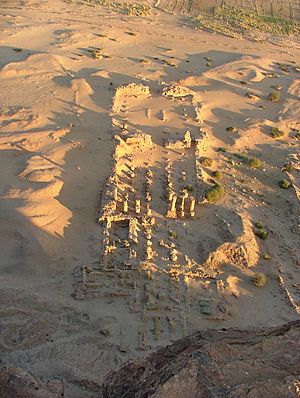
As the ruler of Nubia and Upper Egypt, Piye saw a chance to expand his power. The rulers in Lower Egypt were often fighting among themselves. Piye decided to move his power beyond Thebes and into Lower Egypt.
A ruler named Tefnakht from Sais gathered other local kings from the Delta region. He even convinced Piye's ally, King Nimlot of Hermopolis, to join him. Tefnakht's army then attacked Herakleopolis. The king of Herakleopolis, Peftjauawybast, asked Piye for help.
Piye quickly responded in his 20th year as king. He gathered an army to invade Middle and Lower Egypt. He also visited Thebes during the important Opet Festival, showing he controlled Upper Egypt. His military victories are recorded on the Victory Stela at Gebel Barkal.
Hear what I have done in exceeding the ancestors. I am the king, the representation of god, the living image of Atum, who issued from the womb marked as ruler, who is feared by those greater than he, [whose father] knew and whose mother perceived even in the egg that he would be ruler, the good god, beloved of the gods, the Son of Re, who acts with his two arms, Piye, beloved of Amon ....—Victory Stele of Piye.
Piye saw his military campaign as a Holy War. He ordered his soldiers to perform cleansing rituals before battle. He also offered sacrifices to the god Amun.
Piye marched north and won a complete victory at Herakleopolis. He conquered cities like Hermopolis and Memphis. Many kings from the Nile Delta surrendered to him. These included Iuput II of Leontopolis, Osorkon IV of Tanis, and even his former ally Nimlot. Hermopolis fell to Piye after a five-month siege.
Tefnakht hid on an island in the Delta. He sent a letter to Piye admitting defeat. However, he refused to meet Piye in person. Piye was happy with his victory. He sailed south to Thebes and then returned to Nubia. He never went back to Egypt.
Even after Piye's successful campaign, his direct control mostly stayed in Upper Egypt. The local kings in Lower Egypt, especially Tefnakht, were largely free to rule as they wished. It was Piye's successor, Shebitku, who later took full control by defeating Tefnakht's successor, Bakenranef.
How Long Piye Ruled
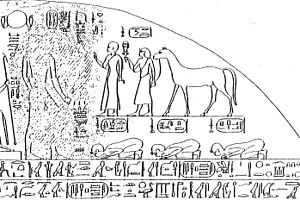
For a long time, people thought Piye ruled for at least 24 years. This was based on a stone tablet found in the Dakhla Oasis. However, in 2006, a tomb was discovered that suggested Piye might have ruled for 27 years.
There are also carvings at the Great Temple at Gebel Barkal. These carvings show Piye celebrating a special festival called a Heb Sed Festival. This festival was usually held in a king's 30th year. It's debated if these carvings show real events or were planned ahead of time. The discovery in 2006 makes it more likely that Piye did rule long enough to celebrate this festival.
Piye's Burial Place
Piye's tomb is located next to the largest Pyramid in the cemetery at el-Kurru. This area is near Jebel Barkal in modern-day Northern Sudan.
His burial chamber was cut into the rock underground. It had a stairway of 19 steps leading down. His body was placed on a bed inside the chamber. Interestingly, his four favorite horses were also buried nearby. Piye was the first pharaoh in over 500 years to be buried in this way. Other kings of his dynasty were also buried at this site later.
The Stele of Piye
The Stele of Piye is a large stone slab covered with writing. It was found in Jebel Barkal and first published in 1872. The stele has text on its front, back, and two thick sides. A full translation into French was published in 1876. This stele tells us a lot about Piye's life and his conquest of Egypt.
Piye in Media
Piye was played by Chris Rochester in a film called The 25th Dynasty. This film was written and directed by Jason Young.
See also
 In Spanish: Pianjy para niños
In Spanish: Pianjy para niños


